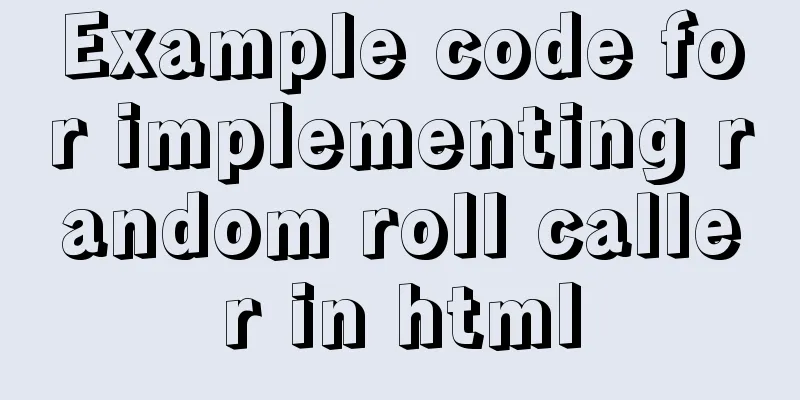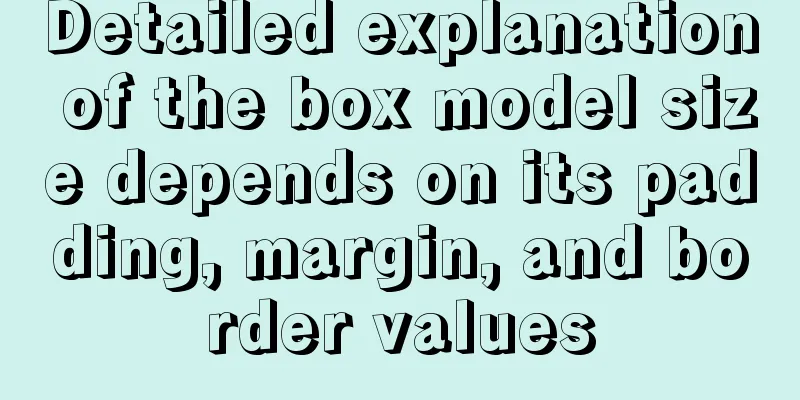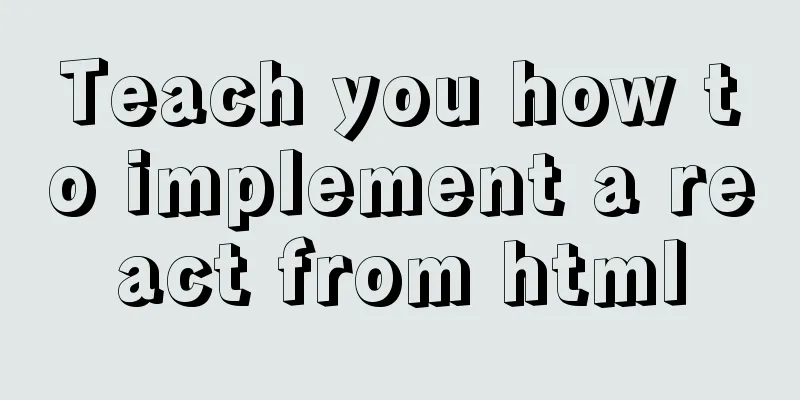Detailed explanation of the use of JavaScript functions

1. Declare a function
//Declare function function name() {
//Function body code}
Function is a keyword for declaring a function. It must be lowercase. Since functions are generally defined to achieve a certain function, we usually name the function as a verb, such as getSum. 2. Calling a function//Call function function name(); //Execute the function body code by calling the function name The code in the function declaration itself will not be executed. The function body code will only be executed when the function is called. 3. Function ParametersWhen declaring a function, you can add some parameters in the parentheses after the function name. These parameters are called formal parameters. When calling the function, you also need to pass corresponding parameters. These parameters are called actual parameters.
The role of parameters: Some values inside a function cannot be fixed. We can pass different values into the function through parameters when calling the function. The problem of mismatch between the number of function parameters and actual parameters
function sum(num1,num2) {
console.log(num1+num2);
}
sum(100,200); //The number of actual parameters is equal to the number of formal parameters, so the correct result is output sum(100,400,500,700); //The number of actual parameters is greater than the number of formal parameters, so only the number of formal parameters is taken sum(200); //The number of actual parameters is less than the number of formal parameters, so the formal parameters are defined as undefined, and the result is NaN
In JavaScript, the default value of a parameter is undefined. 4. Function return valueOften use return to return function values return terminates the function
function add(num1,num2) {
//Function body return num1+num2; //Note: the code after return will not be executed alert('There is a return before, I will not be executed');
}
var resNum = add(21,6); //Call the function, pass in two arguments, and receive the function return value through resNum alert(resNum); //27
If the function has a return, it returns the value after the return; if there is no return, it returns undefined. The difference between break, continue and return
5. Use of argumentsWhen we are not sure how many parameters are passed, we can use arguments to get them. In JavaScript, arguments is actually a built-in object of the current function. All functions have a built-in arguments object that stores all the actual parameters passed.
<!DOCTYPE html>
<html lang="en">
<head>
<meta charset="UTF-8">
<meta http-equiv="X-UA-Compatible" content="IE=edge">
<meta name="viewport" content="width=device-width, initial-scale=1.0">
<title>Document</title>
<script>
function fn() {
console.log(arguments); //It stores all the passed arguments console.log(arguments.length);
console.log(arguments[2]);
//You can traverse arguments as an array
for (var i = 0; i < arguments.length; i++) {
console.log(arguments[i]);
}
}
fn(1, 2, 3);
fn(1, 2, 3, 4, 5);
//Pseudo-array is not a real array //1. It has the length property of an array //2. It is stored in an indexed manner //3. It does not have some methods of a real array such as pop() push(), etc.</script>
</head>
<body>
</body>
</html>
6. A function can call another function
function fn1() {
console.log(111);
fn2();
console.log('fn1');
}
function fn2() {
console.log(222);
console.log('fn2');
}
fn1();
7. Two ways to declare a function
//1. Use function keywords to define custom functions (named functions)
function fn() {
}
fn();
//2. Function expression (anonymous function)
//var variable name = function() {};
var fun = function(aru) {
console.log('I am a function expression');
console.log(aru);
}
fun('FG');
//(1) fun is a variable name, not a function name //(2) The way to declare a function expression is similar to declaring a variable, except that the variable stores a value while the function expression stores a function //(3) Function expressions can also pass parameters SummarizeThis article ends here. I hope it can be helpful to you. I also hope you can pay more attention to more content on 123WORDPRESS.COM! 1. Declare a function
//Declare function function name() {
//Function body code}
Function is a keyword for declaring a function. It must be lowercase. Since functions are generally defined to achieve a certain function, we usually name the function as a verb, such as getSum. 2. Calling a function//Call function function name(); //Execute the function body code by calling the function name The code in the function declaration itself will not be executed. The function body code will only be executed when the function is called. 3. Function ParametersWhen declaring a function, you can add some parameters in the parentheses after the function name. These parameters are called formal parameters. When calling the function, you also need to pass corresponding parameters. These parameters are called actual parameters.
The role of parameters: Some values inside a function cannot be fixed. We can pass different values into the function through parameters when calling the function. The problem of mismatch between the number of function parameters and actual parameters
function sum(num1,num2) {
console.log(num1+num2);
}
sum(100,200); //The number of actual parameters is equal to the number of formal parameters, so the correct result is output sum(100,400,500,700); //The number of actual parameters is greater than the number of formal parameters, so only the number of formal parameters is taken sum(200); //The number of actual parameters is less than the number of formal parameters, so the formal parameters are defined as undefined, and the result is NaN
In JavaScript, the default value of a parameter is undefined. 4. Function return valueOften use return to return function values return terminates the function
function add(num1,num2) {
//Function body return num1+num2; //Note: the code after return will not be executed alert('There is a return before, I will not be executed');
}
var resNum = add(21,6); //Call the function, pass in two arguments, and receive the function return value through resNum alert(resNum); //27
If the function has a return, it returns the value after the return; if there is no return, it returns undefined. The difference between break, continue and return
5. Use of argumentsWhen we are not sure how many parameters are passed, we can use arguments to get them. In JavaScript, arguments is actually a built-in object of the current function. All functions have a built-in arguments object that stores all the actual parameters passed.
<!DOCTYPE html>
<html lang="en">
<head>
<meta charset="UTF-8">
<meta http-equiv="X-UA-Compatible" content="IE=edge">
<meta name="viewport" content="width=device-width, initial-scale=1.0">
<title>Document</title>
<script>
function fn() {
console.log(arguments); //It stores all the passed arguments console.log(arguments.length);
console.log(arguments[2]);
//You can traverse arguments as an array
for (var i = 0; i < arguments.length; i++) {
console.log(arguments[i]);
}
}
fn(1, 2, 3);
fn(1, 2, 3, 4, 5);
//Pseudo-array is not a real array //1. It has the length property of an array //2. It is stored in an indexed manner //3. It does not have some methods of a real array such as pop() push(), etc.</script>
</head>
<body>
</body>
</html>
6. A function can call another function
function fn1() {
console.log(111);
fn2();
console.log('fn1');
}
function fn2() {
console.log(222);
console.log('fn2');
}
fn1();
7. Two ways to declare a function
//1. Use function keywords to define custom functions (named functions)
function fn() {
}
fn();
//2. Function expression (anonymous function)
//var variable name = function() {};
var fun = function(aru) {
console.log('I am a function expression');
console.log(aru);
}
fun('FG');
//(1) fun is a variable name, not a function name //(2) The way to declare a function expression is similar to declaring a variable, except that the variable stores a value while the function expression stores a function //(3) Function expressions can also pass parameters SummarizeThis article ends here. I hope it can be helpful to you. I also hope you can pay more attention to more content on 123WORDPRESS.COM! You may also be interested in:
|
<<: Implementation steps for docker-compose to deploy etcd cluster
>>: Select does not support double click dbclick event
Recommend
Introduction to new features of ECMAscript
Table of contents 1. Default values for functio...
Solve the problem that ifconfig and addr cannot see the IP address in Linux
1. Install the Linux system on the virtual machin...
Detailed explanation of CSS float property
1. What is floating? Floating, as the name sugges...
Mysql optimization tool (recommended)
Preface While browsing GitHub today, I found this...
Application nesting of HTML ul unordered tables
Application nesting of unordered lists Copy code T...
CSS realizes corner cutting + border + projection + content background color gradient effect
Simply use CSS to achieve all the effects of corn...
Analysis of Apache's common virtual host configuration methods
1. Apache server installation and configuration y...
Detailed explanation of docker version es, milvus, minio startup commands
1. es startup command: docker run -itd -e TAKE_FI...
Alibaba Cloud Nginx configures https to implement domain name access project (graphic tutorial)
Step 1: Sign a third-party trusted SSL certificat...
Summary of Problems in Installing MySQL 5.7.19 under Linux
The first time I installed MySQL on my virtual ma...
Vue3.x uses mitt.js for component communication
Table of contents Quick Start How to use Core Pri...
This article will help you understand the life cycle in Vue
Table of contents 1. beforeCreate & created 2...
Implementation of nginx proxy port 80 to port 443
The nginx.conf configuration file is as follows u...
Vue event's $event parameter = event value case
template <el-table :data="dataList"&...
mysql implements adding time automatically adding and updating time automatically updating operation
Time fields are often used in database usage. Com...










